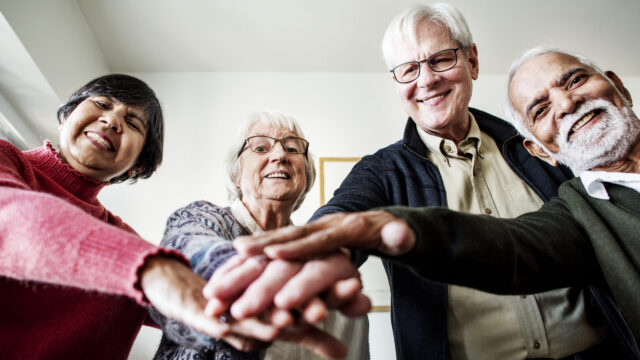What’s Public Health Got to do With… Healthy Living & Aging

February 2022
Excerpted from health.gov Blog, written by the Director of the Office of Disease Prevention and Health Promotion at the Department of Health and Human Services RADM Paul Reed, MD
The lessons of the past year are numerous, but none has been so profound as the value of healthy aging. The COVID-19 pandemic lays bare many of our nation’s most dire vulnerabilities, striking particularly hard at those with chronic disease such as obesity, diabetes, hypertension, and heart disease. Older adults were and continue to be at the highest risk from the virus, suffering mortality rates deeply disproportionate to the overall population, especially where these comorbid conditions are present. COVID-19 highlights how these conditions diminish one’s resilience to the virus and worsen the effects of the disease. COVID-19 also emphasizes the imperative that we, as a Nation, must address underlying health disparities that contribute to these disproportionate effects and the inequities that drive these disparities.
Across the board we see poorer outcomes in those with chronic and often preventable conditions. A lack of adequate physical activity, poor diet, and inequities in the social determinants of health that influence one’s opportunity to make healthy choices contribute significantly to the development of these conditions. In turn, this makes us more vulnerable to disruptions to our lives—disruptions like COVID-19—and negatively impacts our overall quality of life, especially as we age into later life.
The good news is that by developing and maintaining healthy aging practices throughout our lifespan, we can do a lot to minimize our vulnerabilities. Science supports several ways to meet the challenge, including staying physically and mentally active, focusing on proper diet and nutrition, increasing our personal health literacy, and maintaining support networks with friends and family. In other words, a commitment to healthy living at any point in one’s life is the first step toward healthy aging in later life—a process by which an individual may achieve their own optimal state of physical, mental, and social well-being.
You may personify, or you may know of someone who personifies, this healthy aging ideal. For me, it’s a former colleague and friend. He’s spent his life enjoying physical activity, particularly in the outdoors, climbing mountains and exploring wilderness, all the while understanding the necessity and joy of proper nutrition, staying aware of his own health needs, and placing a high value on maintaining his relationships with family and friends. Now in retirement, he’s still an avid outdoorsman who modifies his exploration as his abilities dictate. But he shows no signs of stopping—nor should he. He’s made an investment in his health and he continues to reap the rewards.
Some of you may be saying, “But he’s spent his life doing that, and I’m already in my 40s or 50s or even my 60s, so why bother at this point?” My response is that it’s never too late. The Physical Activity Guidelines for Americans detail how even small amounts of physical activity can begin to accumulate benefits—some immediately after being active—and at all ages. The newest edition of the Dietary Guidelines for Americans shows that healthy eating is for everyone, at all life stages. And evidence demonstrates that curtailing and quitting certain unhealthy habits, such as smoking—even for those who’ve smoked for many years—can reduce risks for a host of diseases. These are just a few of the many examples of the science supporting the notion that taking steps towards better health now can improve both long and short-term outcomes, as well as fortify our overall resilience as we age—at any age and well into later life!
And that’s really what healthy aging is all about—resilience. Developing and maintaining personal health and healthy aging habits can help gird you against the next immediate stress on your body or even the next pandemic. While it’s not a magic formula by any means, there’s no question that building personal resilience moves the odds closer to your favor. Scientific advances of the past 120 years have driven the largest overall increases in human life expectancy, so it’s only natural that we ready ourselves to ensure that the years we’ve gained are of higher quality and afford us more independence. Just remember that no matter how old you are, you’re never too old to start optimizing your health and well-being.
COVID-19 has clearly shown us that, for far too long, we have given little credence to the fact that our social circumstances greatly influence our ability to make healthy choices and therefore impact our inherent resilience. We, collectively, must grapple with improving the environments within which people live, especially those that have historically been most disadvantaged. The social determinants of health and our opportunities for healthy living vary tremendously across the nation. To be able to choose to live healthfully demands a more equitable standard, and that responsibility belongs to all of us.